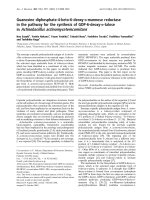Survey for little leaf of brinjal disease (Candidatus phytoplasmatrifolii) incidence in Northern Karnataka, India - TRƯỜNG CÁN BỘ QUẢN LÝ GIÁO DỤC THÀNH PHỐ HỒ CHÍ MINH
Bạn đang xem bản rút gọn của tài liệu. Xem và tải ngay bản đầy đủ của tài liệu tại đây (351.61 KB, 6 trang )
<span class='text_page_counter'>(1)</span><div class='page_container' data-page=1>
<i><b>Int.J.Curr.Microbiol.App.Sci </b></i><b>(2017)</b><i><b> 6</b></i><b>(11): 1248-1253 </b>
1248
<b>Original Research Article </b>
<b>Survey for Little Leaf of Brinjal Disease (</b>
<i><b>Candidatus phytoplasmatrifolii</b></i>
<b>) </b>
<b>Incidence in Northern Karnataka, India </b>
<b>Rathnamma* and M.S. Patil </b>
Department of Plant Pathology, University of Agricultural Sciences,
Krishinagar, UAS, Dharwad-580005, Karnataka, India
<i>*Corresponding author </i>
<i><b> </b></i> <i><b> </b></i><b>A B S T R A C T </b>
<i><b> </b></i>
<b>Introduction </b>
The brinjal or eggplant (<i>Solanum melongena </i>
L.) belongs to the family Solanaceae. Brinjal
is the most common, popular and widely
grown vegetable crop of both tropics and
sub-tropics of the world. Brinjal is a
self-pollinated and annual herbaceous plant. It is
being grown extensively in India, Bangladesh,
Pakistan, China, Philippines, France, Italy and
United States. Vavilov (1931) reported that
India is the centre of origin. It is highly
productive and finds its place as the poor
man’s vegetable (Som and Maity, 2002).
It is grown in almost all parts of India, except
in higher altitudes throughout the year.
Brinjal is affected by several diseases of
which little leaf causing phytoplasma is one
of the most important disease causing
considerable economic losses (Mitra, 1993).
The infected plants are characterized by
severe stunting, shortened internodes,
proliferation of shoots, and reduction in leaf
size and phyllody of flowers. Brinjal little leaf
disease was first reported in the central farm,
Coimbatore by Thomas and Krishnaswamy
(1939) and several biological aspects of the
disease have been described (Varma <i>et al.,</i>
1969; Mitra, 1993). The insect vector,
<i>Hishimonus phycitis </i>Distant was reported by
(Bindra and Singh, 1969).
<i>International Journal of Current Microbiology and Applied Sciences </i>
<i><b>ISSN: 2319-7706</b></i><b> Volume 6 Number 11 (2017) pp. 1248-1253 </b>
Journal homepage:
Little leaf disease caused by phytoplasma (<i>Candidatus phytoplasmatrifolii</i>)
is one of the important diseases in Brinjal. In recent years incidence of little
leaf disease is increasing in Karnataka. The roving survey was undertaken
to know the incidence of little leaf phytoplasma disease of brinjal in
different parts of northern Karnataka <i>viz.</i>, Dharwad, Belgaum and Haveri
districts during <i>kharif</i>, 2013. It was evident that the disease was severe in
all the districts during <i>kharif</i>, 2013 and the average disease incidence
recorded from 20.55 to 35.44 per cent in northern Karnataka. The
maximum disease incidence of 35.44 per cent was recorded at Dharwad
district followed by Belgaum district 32.48 per cent and minimum disease
incidence was noticed in 20.55 per cent in Haveri district.
<b>K e y w o r d s </b>
<i>Candidatus </i>
<i>phytoplasmatrifolii,</i>
Brinjal, Little leaf.
<i><b>Accepted: </b></i>
12 September 2017
<i><b>Available Online:</b></i>
10 November 2017
</div>
<span class='text_page_counter'>(2)</span><div class='page_container' data-page=2>
<i><b>Int.J.Curr.Microbiol.App.Sci </b></i><b>(2017)</b><i><b> 6</b></i><b>(11): 1248-1253 </b>
1249
Plants infected with phytoplasmas exhibit
symptoms suggesting a profound disturbance
in the normal balance of growth regulators,
leading to virescence/ phyllody i.e.,
development of green leaf-like structures
instead of flowers, sterility of flowers,
proliferation of axillary buds resulting in
―witches broom‖ symptoms, abnormal
internode elongation and generalized stunting
(Bertaccini, 2007). Phytoplasmas are
transmitted by insects belonging to the
families’ viz., Cicadellidae, Cixidae,
Psyllidae, Delphacidae and Derbidae
(Weintraub and Beanland, 2006).
<b>Materials and Methods </b>
The roving survey was conducted during
<i>kharif</i>/summer season 2013 to know the per
cent disease incidence of little leaf of brinjal
and prevalence of leafhopper populations in
three major brinjal growing areas of
Karnataka <i>i.e. </i>Dharwad, Belgaum and Haveri
districts. In each village five fields were
selected and the percent of disease incidence
was assessed by recording the number of
plants showing disease symptoms and the
total number of plants examined by using the
formula.
Number of diseased plants
Disease incidence (%) = —————— x 100
Total number of plants examined
<b>Results and Discussion </b>
The roving surveys were undertaken to know
the incidence of little leaf phytoplasma
disease of brinjal in different parts of
Northern Karnataka <i>viz.</i>, Dharwad, Belgaum
and Haveri districts during kharif, 2013 when
the crop was in flowering stage and fruiting
stage. During survey brinjal plants showing
typical symptoms of reduction in the size of
the leaves, leaf curling or cupping, Yellowing,
reduction in the petiole and the lamina, flower
is converted into leaf like structure,
Malformation of brinjal fruits were observed
(Fig. 1).
From the survey it is revealed that the disease
was severe in all the districts during kharif,
2013 and disease incidence ranged from 2 to
95 per cent in different parts of the districts
surveyed. The highest incidence (95%) of
Little leaf phytoplasma disease was noticed in
fields of Garaga village in Dharwad district,
whereas least (2%) incidence of the disease
was recorded at Hedigonda village of district
Haveri.
<b>Village wise incidence </b>
</div>
<span class='text_page_counter'>(3)</span><div class='page_container' data-page=3>
<i><b>Int.J.Curr.Microbiol.App.Sci </b></i><b>(2017)</b><i><b> 6</b></i><b>(11): 1248-1253 </b>
1250
<b>Table.1</b> Incidence of brinjal little leaf in various villages in
northern Karnataka during <i>kharif </i>2013
Dharwad District
Taluk Villeges name Incidence (%)
Dharwad
UAS, Campus 10.00
Narendra 16.00
Garaga 95.00
Govanakoppa 37.50
Somapura 15.00
Sulla 25.00
Byahatti 12.00
Shivalli 45.00
Tadakoda 35.00
Hubli Bhadrapura 38.00
Annigere 30.00
Hebsur 60.00
Siraguppi 36.00
Kundagol Kundagol 70.00
Saunsi 15.00
Gudigeri 25.00
Devanuru 30.00
Kambadhalli 45.00
Navalagund Alagavadi 20.00
Amaragol 5.00
Belavatagi 36.4
Karalawada 22.5
Karalgund 50.00
Kalagatagi Hulikoppa 32.00
Hirenalli 30.00
Devikoppa 42.00
Dummavada 57.50
Belgaum District
Taluk Villages name Incidence (%)
Savadatti Hirehulligere 40.00
Kabbenuru 18.00
Karikatte 24.8
Yadalli 14
Inchal 55.4
Bailahongal Muragoda 90.00
Belavadi 65.00
Kenganura 44.2
Nesargi 25.00
Madanabavi 20.00
Gokak Tukkanatti 40.00
Kallolli 11.00
Kolvi 20.00
Gilihosaru 34.6
Ankalagi 12.00
Chikodi Nagarmunoli 15.00
Navalihal 14.00
Shamanewadi 37.4
</div>
<span class='text_page_counter'>(4)</span><div class='page_container' data-page=4>
<i><b>Int.J.Curr.Microbiol.App.Sci </b></i><b>(2017)</b><i><b> 6</b></i><b>(11): 1248-1253 </b>
1251
Yamakanamaradi 61.4
Sankeshwar 7.00
Haveri District
Taluk Villages name Incidence (%)
Haveri Devihosur 8.0
Nelogalla 10.3
Devagiri 26.5
Haveri 25.00
Ranebennur Ranebennur 36.7
Halageri 23.00
Hanumanamatti 9.00
Kakola 15
Byadagi Byadagi 34.7
Hedigonda 2
Sidenur 13.0
Kanamadi 6.4
Hirekerur Hirekerur 15.00
Hamsabhavi 23.00
Hanagal Akkihalur 44.5
Negavanagi 24.8
Tilavalli 25.00
<b>Table.2</b> Average incidence of brinjal little leaf in various taluks of northern Karnataka
during <i>kharif </i>2013
<b>Taluk</b> <b>Number of villages surveyed</b> <b>Incidence range</b> <b>Incidence average</b>
<b>Dharwad district</b>
Dharwad 9 10-95 32.20
Hubli 4 30-60 41.00
Kundagol 5 15-70 37.00
Navalagund 5 5-50 26.70
Kalagatagi 4 30-57 40.30
<b>Average 35.44</b>
<b>Belgaum district </b>
Savadatti 5 14-55.4 30.40
Bailahongal 5 20-90 48.80
Gokak 5 11-40 23.50
Chikodi 3 14-37.4 22.10
Hukkeri 3 7-44.6 37.60
<b>Average 32.48 </b>
<b>Haveri district</b>
Haveri 4 8-26.5 17.45
Ranebennur 4 9-36.7 20.90
Byadagi 4 2-34.7 14.00
Hirekerur 2 15-23 19.00
Hanagal 3 24.8-44.5 31.40
</div>
<span class='text_page_counter'>(5)</span><div class='page_container' data-page=5>
<i><b>Int.J.Curr.Microbiol.App.Sci </b></i><b>(2017)</b><i><b> 6</b></i><b>(11): 1248-1253 </b>
1252
<b>Table.3</b> Little leaf disease of brinja incidence - District wise
<b>Sl. No. </b> Di District N Number of fields Pe Percent Disease Incidence
minimum M
maximum
A
Average
11 1 Dharwad 135 5 95 50
2 Belgaum 105 7 90 48.5
3 Haveri 85 2 44.5 23.25
<b>Fig.1</b> Brinjal little leaf disease symptoms
<b>Taluk wise incidence </b>
The incidence in Dharwad district taluks, the
maximum incidence of 41 per cent was
recorded in Hubli taluk followed by 40.3 and
37 per cent in Kalagatagi and Kundagol taluk
respectively. However, the minimum
incidence of 26.7 per cent was recorded in
Navalagund taluk. The incidence in Belgaum
district taluks, the maximum incidence of 48
per cent was recorded in Bailahongal taluk
followed by 37.6 and 30.4 per cent in Hukkeri
and Savadatti taluk respectively. However,
the minimum incidence of 22.1 per cent was
recorded in Chikodi taluk. The incidence in
Haveri district taluks, the maximum incidence
of 31.4 per cent was recorded in Hanagal
taluk followed by 20.9 and 17.45 per cent in
Ranebennur and Haveritaluk respectively.
However, the minimum incidence of 14 per
cent was recorded in Byadagi taluk (Table 2).
<b>District wise incidence </b>
On an average, the maximum disease
incidence of 35.44 per cent was recorded at
Dharwad district followed by Belgaum
district 32.48 per cent and minimum disease
incidence was noticed in 20.55 per cent in
Haveri district (Table 3).
The roving survey during <i>kharif</i>2013 was
undertaken to know the incidence of little leaf
phytoplasma disease of brinjal (<i>Solanum </i>
<i>melongena </i> L.) in northern Karnataka. The
results revealed that the per cent disease
incidence varied from place to place.
</div>
<span class='text_page_counter'>(6)</span><div class='page_container' data-page=6>
<i><b>Int.J.Curr.Microbiol.App.Sci </b></i><b>(2017)</b><i><b> 6</b></i><b>(11): 1248-1253 </b>
1253
<b>References </b>
Bertaccini, A., 2007, Phytoplasmas: diversity,
taxonomy, and epidemiology.
<i>Frontieres in Biosci.,</i> 12: 673–689.
Bindra, O. S. and Singh, B., 1969, Biology
and bionomics of <i>Hishimonusphycitis </i>
(Distant), a jassid vector of little leaf
disease of brinjal (<i>Solanum melongena </i>
L.). <i>Indian J. Agric. Sci., </i>39: 912-919.
Mitra, D. K., 1993, little leaf, a serious
disease of eggplant (<i>Solanum </i>
<i>melongena</i>). In: Management of plant
diseases caused by fastidious
prokaryotes, edited by Raychaudhuri, S.
P. and Teakle, D. S., India, New Delhi:
Associated Publishing Co., pp. 73-78.
Som, M., G. and Maity, J. K., 2002, Brinjal
vegetable crops, 3rd revised edition, Ed.
Bose, T. K., Kabir, J., Maity, T. K.,
Parthasarthy, V. A. and Som, M. G.,
Nayaprakash publishers, Kolkatta. 1:
265-344.
Thomas, K. M. and Krishnaswami, C. S.,
1939, "Little-leaf"—a transmissible
disease of brinjal. <i>Proc. Indian Acad. </i>
<i>Sci., </i>10: 201-212.
Varma, A., Raychaudhuri, S. P., Chenulu, V.
V., Singh, S., Ghosh, S. K. and Prakash,
N., 1969, Yellows Type of Diseases in
India: Eggplant little leaf. <i>Division of </i>
<i>Mycology and Plant Pathology, Indian </i>
<i>Agricultural Research Institute</i>, <i>New </i>
<i>Delhi</i>.
Vavilov, N. I., 1931, The role of central Asia
in the origin of cultivated plants. <i>Bull. </i>
<i>Appl. Bot. Genet. Pl. Breed, </i>26(3): 3-44.
Weintraub, P. G. and Beanland, L., 2006,
Insect vectors of phytoplasmas. <i>Ann. </i>
<i>Rev. Entomol., </i>51: 91-111.
<b>How to cite this article: </b>
</div>
<!--links-->
Tài liệu Guidelines for the appointment of General Practitioners with Special Interests in the Delivery of Clinical Services pdf
- 11
- 489
- 0


![Standard Test Method for Compressive Strength of Hydraulic Cement Mortars (Using 2-in. or [50-mm] Cube Specimens)](https://media.store123doc.com/images/document/14/rc/yi/medium_yil1395845738.jpg)





